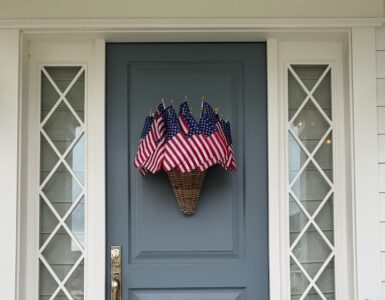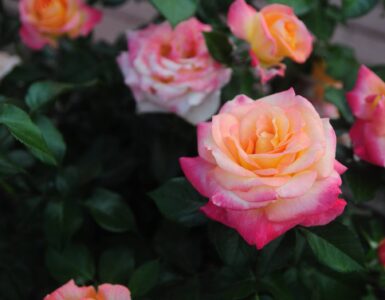Teresa Hunsaker with Utah State University Extension Service’s in Weber County shares some tips on
Studio 5.
Cleaning Patio Furniture: Getting reading
Before using water to clean patio furniture, wipe or brush off any large debris like leaves or sticks. Using a nylon bristled brush, scrub off things like mud and bird droppings. After a dry brush and a wipe, use the hose to wet the rest of the grime.
Cleaning regular aluminum on patio furniture:
Plastic scrubber or fine steel wool
Dish detergent
1. Place a good amount of detergent on your plastic scrubber or steel wool and begin to scrub.
2. When you are finished, rinse the furniture real well and let it dry.
Cleaning baked on dirt from aluminum:
Dish detergent or your favorite all-purpose cleaner
High quality car wax
1. Soak the sponge up well with dish detergent or all-purpose cleaner.
2. Work it into the furniture until you get it nice and clean.
3. Rinse off all the detergent or cleaner.
4. Dry it with a soft cloth.
5. Place car wax on a soft cloth or the applicator that comes with it.
6. Work the wax onto the aluminum really well, being careful not to get any on the webbing or the fabric—it will leave a terrible spot once dried and exposed to the heat. Wash any off fabric right away.
7. Let the wax dry and then buff it off.
Cleaning white plastic furniture (vinyl:
1 gallon warm water
3 Tsp. automatic dishwashing detergent
Sponge with scrubber on back
Bucket
1. Place 1 gallon warm water in a bucket and add 3 teaspoons of automatic dishwasher detergent.
2. Wash down the furniture with this solution.
3. Let the solution set on the furniture for approximately 15 minutes. (The dishwashing detergent has a bleaching agent in it that will whiten the furniture.)
4. Rinse and dry.
Note:Clean colored furniture with an all-purpose cleaner and water. Make sure you rinse it well because sunlight and weather will hurry the fading process along. The vinyl on strapped furniture should be kept clean and free from body oils and tanning lotions or sun block. Use a towel or provide pads for use on chaise loungers and chairs. Apply a vinyl protectant to the straps after cleaning.
Most outdoor furniture pads have machine washable covers or the entire pad may be washed. Follow the manufacturers’ suggestions for fabric care.
Umbrellas require maintenance after being in storage. Covers need washing and umbrella frame joints need oiling. Wash covers using a soft-bristled brush, mild soap and cold water. Use a spray lubricant on the joints of a wire-frame umbrella. If you have a wooden-frame umbrella, use paste wax to restore its shine.
Mildewed patio umbrella: Bleach is the best product to use to kill and clean mildew, however some fabrics and umbrella materials may not be conducive to bleach—so consider carefully. Then, open umbrella and gently lay it on its side. Mix a solution of 1/2 cup liquid bleach and a squirt of liquid dishwashing detergent with 1 gallon warm water. Dab on inside seam first to test colorfastness. Never use bleach on acrylic prints — it will cause fading; instead, check manufacturer’s label for cleaning instructions if you have them. Wear rubber gloves and use a soft-bristle brush to scrub one section at a time. Rinse fabric with a garden hose and dry metal hardware with a cloth. Let fabric dry before placing umbrella in stand.
Wicker: Vacuum wicker with the soft-brush attachment to remove dust and flaking paint, then wipe with a damp cloth. If it still looks bad, sand or strip the piece and repaint.
A note about cushions: Fabric and cushioning play a big role in determining patio-furniture quality. When cheaper cushions are left in the rain, they tend to retain moisture and to develop mildew problems. The interior of a cushion also makes a big difference. Cheaper cushions filled with shredded foam quickly get dirty and begin to mildew. Higher-quality cushions use a polyester fiber filling that sheds water easily and allows fresh air to pass through so mildew can’t grow as readily.
The exterior of a cushion is just as important, but it can be difficult to tell the difference between one fabric and another. More expensive fabrics are usually solution-dyed (each thread is dyed) so they don’t fade. Another indicator is the pattern: cheaper fabrics often show the pattern on only one side of the cushion.
Fabric Care…
To keep your furniture looking its best for years to come, we recommend some minimal care…
Casual furniture fabrics can survive with a little neglect. However, with care and periodic cleaning they will thrive, retaining their good looks far longer. Always read the fabric hangtags that come with the new furniture.
Mildew grows in dirt, a good reason to address stains promptly and keep furniture clean. Rinsing is very important. If soap is left, it becomes sticky and attracts more dirt. If bleach is left, it may breakdown fibers and weaken their strength. Taking cushions in when not in use will help to extend their good looks. In the winter, store cushions or slings out of the elements or, at least, keep them covered. Doing so will save a major spring clean up.
1. Acrylic Fabrics
Some brands will advertise that their canopies are made of solution-dyed acrylic fabrics. What this phrase means is that the manufacturer has dyed the acrylic with a chemical solution. Solution-dyed fabric, on the other hand, holds up well to outdoor wear and tear. It also resists fading from the sun’s rays. Canopies for umbrellas and cushions for patio furniture all benefit from the solution-dyeing process. Use a solution of lukewarm water and mild soap. Be sure to rinse thoroughly. Very important: Never use bleach or harsh detergents on an acrylic print.2. Vinyl Coated Polyester Fabrics
Wash with a solution of soap or mild detergent and water. Rinse very thoroughly. Very important: Never use bleach or any other harsh cleaner on printed polyester.3. Olefin Fabrics
Brush off any dirt and clean with a solution of lukewarm water and mild soap. Sponge thoroughly with water. For stubborn stains or mildew, mix three gallons of warm water with one cup of household bleach and one cup of mild detergent. Rinse thoroughly.4. Acrylic/Olefin Blend Fabrics
For basic dirt, use lukewarm water and mild detergent. For heavy stains, wash with a solution of one gallon of water, one cup of bleach and two capfuls of dish detergent. Rinse thoroughly.
Wood picnic table: To clean up unfinished wooden furniture, scrub surface with a mixture of 1 cup household ammonia, 1/2 cup vinegar and 1 gallon water. Rinse well and wipe with an absorbent cloth to remove excess moisture. Wooden outdoor furniture that has been coated with an exterior-grade varnish can be cleaned using soapy water. Be sure to completely rinse the furniture with clean water.
Wrought Iron:
Consider washing wrought iron patio furniture seasonally to keep it looking its best. Avoid corrosion issues by maintaining the painted finish of your wrought iron patio furniture. If you see a nick in the paint, touch it up immediately.
Protect the gloss on non-textured wrought iron patio furniture with a little car wax. If your wrought iron patio furniture has texture to it, try using mineral or baby oil. Wipe down any spots left from suntan lotions or insect repellents to avoid permanent discoloration.
Outdoor furniture is a large investment and not something you want to replace every spring. With proper care and cleaning, you can enjoy your outdoor furniture for many years. When furniture is purchased new, care instructions are usually included. Over the years, these instructions have a tendency to get lost. The ideas listed above can serve as a quick reference to maintain your outdoor furniture.
Resources:
Lowe’s Home Center
Linda Cobb, The Queen of Clean
Hints from Heloise—Good Housekeeping
www.backyard.cc/care.asp
If you have any questions, call the Family and Consumer Science Education Department at the Weber County USU Extension office at (801) 399-8203 or online at www.extension.usu.edu/weber















Add comment